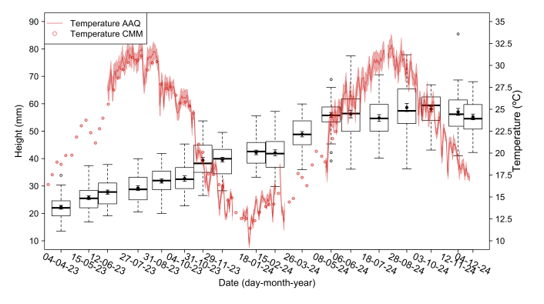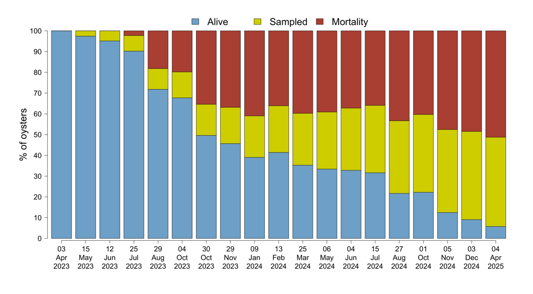FIRST STEPS FOR THE USE OF SALTPANS IN THE RESTORATIVE AQUACULTURE OF THE NATIVE EUROPEAN OYSTER
Introduction
Restorative aquaculture pretends to address the growing demand of food production while delivering net ecological benefit to ecosystems along with social and economic advantages (Alleway et al. 2023) . This approach prioritizes the cultivation of low-trophic-level aquatic organisms whose biological functions enhance ecosystem processes such as nutrient cycling, water filtration, and habitat provision. This statement is the cornerstone of the Mar Menor Oyster Initiative (MMOI), an initiative which aims to use bivalves as Nature Base Solutions (NbS) to improve the Mar Menor lagoon (MM) condition. The MM is the largest hyperhaline lagoon in the Mediterranean basin and since the 1970s has been increasingly threatened by a eutrophication process. The lagoon ecosystem collapsed in 2016 as a result of a phytoplankton bloom which caused biodiversity loss, hypoxia and the collapse of the ecological structure (Ruiz et al. 2020). The MMOI has focused on the recovery of the European native oyster (Ostrea edulis ) to establish a restorative aquaculture program to leverage the ecosystem services provided by the species (Albentosa et al. 2023) . This species established a large population in the lagoon of over 100 million individuals in the 1980s and 1990s that has been disappearing, partly due to ecosystem degradation (Rosique 2006). As a first step in the initiative, an oyster culture is taking place in a saltpan located in the north of the MM. In the present work we present two years of growth and survival of the oyster culture in the saltpan.
Material and methods
O. edulis individuals were obtained by breeding lagoon’s broodstock at the hatchery (Hernandis et al. 2023) . In March 2023, a total of ≈5800 seed were translocated and maintained during 24 months in the entrance canal of the saltpans from San Pedro del Pinatar, located in the north basin of the MM. Initially, oyster height size was 22.24 ± 0.70 mm and live weight was 1.51 ± 0.10 g. The oysters were distributed in circular oyster’s baskets stacked in groups of 5. A total of 3 – 6 groups (15 – 30 baskets) were hold, depending on the number and size of the oysters throughout the experiment, in order to maintain a suitable density. Temperature was constantly monitored in the canal throughout experiment.
Once a month approximately, t he total live weight of all the oysters was measured and three subsamples of 50 individuals were collected to check for the percentage of mortality and measure size. Besides, a complete biometry with dissections was done in 40 individuals, measuring height, length, width, live weight and dry weight.
Results and discussion
The maximum temperature recorded in the canal was 34ºC. During the first summer (2023), a high mortality of 38% of the individuals was observed. During the second summer the mortality increased up to 50%. Shell growth followed a seasonal pattern, with higher increases from spring to late summer and lower during the colder months, except for the summer, when shell growth continued while meat weight decreased. Meanwhile, oysters’ meat weight followed a similar pattern, but showing a decrease in weight during the warmer months. Condition index followed a similar pattern, probably affected also but the higher temperatures but also the reproductive season, which usually occurs in spring-summer for the MM.
Acknoledgments
This study has been funded by the RESALAR ( Biodiversity Foundation of the Ministry of Ecological Transition and the Demographic Challenge -MITECO- ) and THINKINAZUL (PRTR-C17.I1 , from the Spanish Ministry of Science and the Murcia Region) projects.
References
Albentosa M, …..,Martínez P (2023) Recovery of eutrophized marine ecosystems using the European flat oyster, Ostrea edulis. Aquatic Conservation: Marine and Freshwater Ecosystems 33: 645-660.
Alleway HK, …, Jones RC (2023) Global principles for restorative aquaculture to foster aquaculture practices that benefit the environment. Conservation Science and Practice 5: e12982.
Hernandis S, …., Albentosa M (2023) Hatchery seed production of flat oysters from the Mar Menor lagoon. Frontiers in Marine Science 10.
Rosique MJ (2006) Evaluación del banco natural de ostra plana del Mar Menor. Comunidad Autónoma de la Región de Murcia. Consejería de Agricultura y Agua. Servicio de Pesca y Acuicultura., Murcia
Ruiz JM, … ,Yebra L (2020) Informe de evolución y estado actual del Mar Menor en relación al proceso de eutrofización y sus causas. Informe de asesoramiento técnico del Instituto Español de Oceanografía (IEO)

